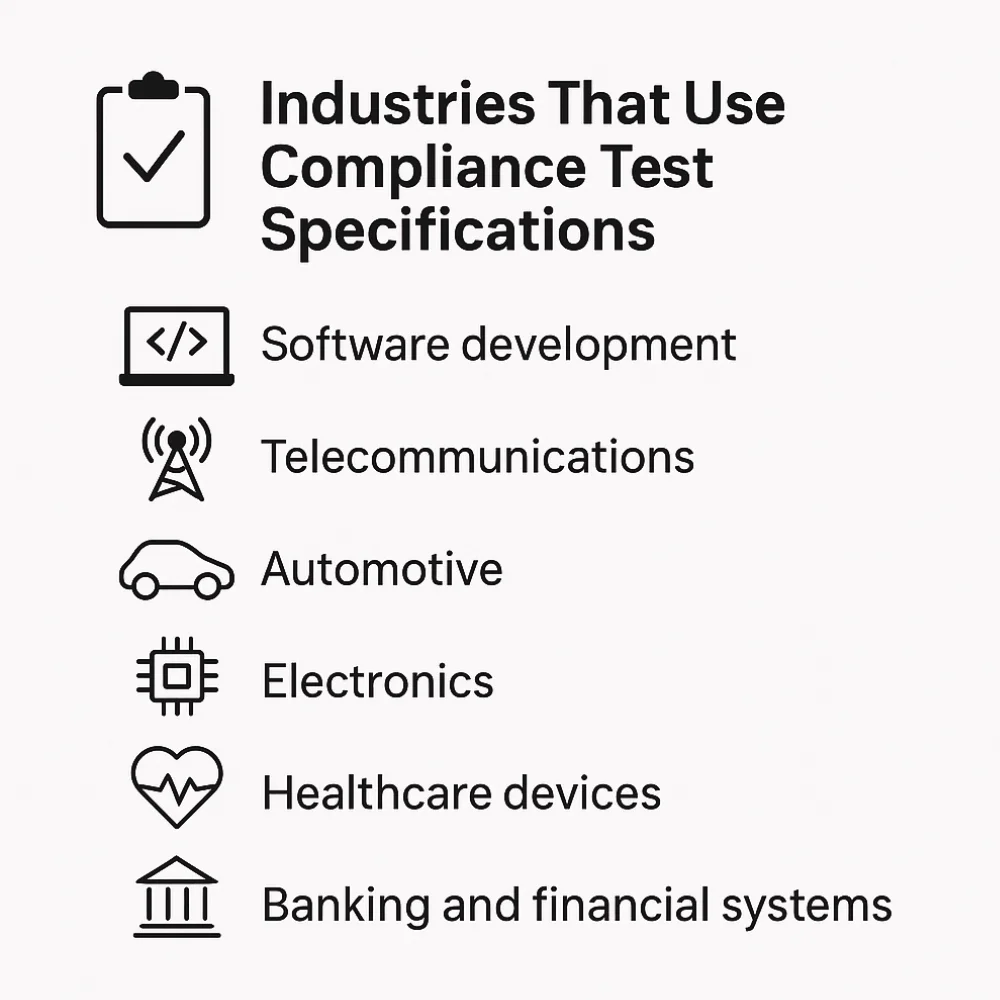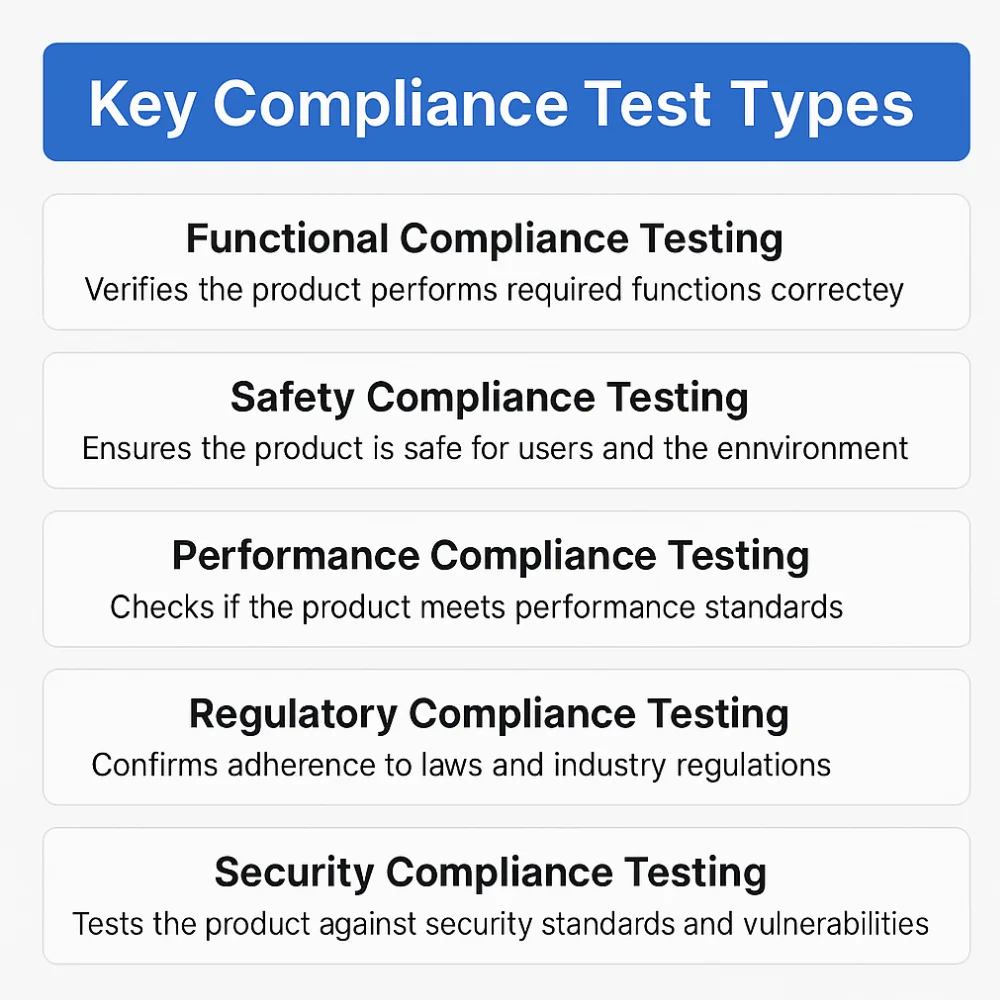Compliance test specifications define how to test products to ensure they meet required standards. They apply to software, hardware, and industrial systems alike. In short, they confirm that everything works as expected under set rules.
What Is a Compliance Test Specification?
A compliance test specification is a document guiding testers on how to verify a product meets specific standards or regulations. It outlines comprehensive test procedures, anticipated outcomes, and clear criteria for determining pass or fail status. Think of it as a checklist ensuring everything complies with safety and quality requirements.
Why Compliance Testing Matters?
Compliance testing is very important for several reasons. It helps protect users, ensures high quality, and avoids legal trouble. Without proper testing, faulty products might reach the market, putting people at risk and causing businesses to lose trust and money.
Here are a few reasons why compliance testing is so important:
- Legal Requirements: Some industries, like healthcare and finance, must follow strict laws. If a product or system doesn’t meet these laws, companies can face heavy fines or shutdowns.
- Safety and Security: For physical products like cars or electrical devices, non-compliance can lead to dangerous situations.
- Market Access: In some countries, products must pass compliance tests before they can be sold.
- Customer Trust: A tested and approved product builds more trust with users and partners.
Where Is Compliance Test Specification Used?

Compliance test specifications are used in many industries, including:
- Software development
- Telecommunications
- Automotive
- Electronics
- Healthcare devices
- Banking and financial systems
- E-commerce platforms
Let’s take a simple example from software. Imagine a company building a banking app. The app must follow security standards like encryption and user authentication. A compliance test specification will outline the tests needed to check these features. If the app passes all the tests, it’s ready to go live.
Key Components
A good compliance test specification includes many elements to make sure the tests are clear, accurate, and repeatable. These components include:
- Objective: What is being tested and why.
- Scope: Specifies the functionalities or sections of the product that will be included in the testing process.
- Test Environment: The tools, systems, and settings needed for testing.
- Test Cases: Detailed steps to perform each test.
- Expected Results: What the correct output or behavior should be.
- Pass/Fail Criteria: Clear rules to decide whether the test passed or failed.
- Traceability: Linking each test back to the specific requirement or regulation it is checking.
How Compliance Test Specifications Are Created?
Creating a compliance test specification is a careful process. It usually starts with reading and understanding the regulations or standards that apply. Then, the test team creates a plan to check whether the product meets these rules. The specification is often reviewed by different teams like development, legal, and quality assurance.
The process typically follows these steps:
- Identify applicable standards or regulations
- Break down the requirements into testable parts
- Design test cases based on those requirements
- Define what success looks like for each test
- Document all steps and expected results
- Review and approve the test specification
- Run the tests and record results
Benefits
Using a compliance test specification has many advantages. It ensures alignment among team members and enhances the efficiency and reliability of the testing process. Some key benefits include:
- Clarity and Consistency: Everyone knows what needs to be tested and how.
- Better Quality Control: Tests catch issues early, saving time and money later.
- Easier Audits: Clear records help during inspections or certification processes.
- Reduced Risk: Avoids fines, lawsuits, and product recalls.
Types of Compliance Tests

Compliance testing can vary depending on the industry and product. Common types include:
- Functional Compliance Testing: Verifies the product performs required functions correctly.
- Safety Compliance Testing: Ensures the product is safe for users and the environment.
- Performance Compliance Testing: Checks if the product meets performance standards.
- Regulatory Compliance Testing: Confirms adherence to laws and industry regulations.
- Security Compliance Testing: Tests the product against security standards and vulnerabilities.
Each type targets specific requirements and often requires different testing approaches.
Common Challenges
While compliance testing plays a crucial role, it often presents significant challenges. Some of the most common problems teams face include:
- Changing Regulations: Laws and standards often change, requiring updates to test specifications.
- Complex Products: Some systems have many parts, making it hard to test everything properly.
- Time Pressure: Teams may rush testing to meet deadlines.
- Lack of Resources: Not having enough tools, time, or skilled staff can hurt test quality.
To deal with these issues, companies often invest in training, automation tools, and regular updates to their test processes.
Real-World Example
Let’s say a company is developing a new smartphone. Before it can be sold in the European Union, the phone must pass specific tests for electrical safety and radiation levels. The compliance test specification for this would include:
- Test cases for measuring radiation output
- Steps to check battery safety under different temperatures
- Criteria for electromagnetic interference
The testing team would follow this document step by step. Only when all tests are passed would the phone be approved for sale.
Tools That Help With Compliance Testing
Modern tools can make compliance testing easier and more accurate. Some helpful tools include:
- Test management software: Used to structure, manage, and monitor test cases throughout the testing lifecycle.
- Automation tools: To run repeated tests faster and with fewer errors.
- Reporting tools: To create reports for managers, auditors, or government bodies.
- Requirement management software: To link tests directly to rules or laws.
Popular tools include JIRA, TestRail, HP ALM, and Selenium (for automated web testing). These tools help teams stay organized, improve speed, and reduce human error.
Best Practices
To get the most out of compliance test specifications, follow these best practices:
- Keep specifications up to date with the latest standards.
- Use clear and simple language in your documents.
- Involve all relevant teams, such as legal, engineering, and QA.
- Automate tasks whenever feasible to improve efficiency and minimize the risk of human error.”
- Regularly review test results and make improvements.
- Provide training for team members on compliance requirements.
Conclusion
Compliance test specifications are essential for ensuring products meet regulations. They provide a clear testing plan that improves quality, reduces risk, and builds trust. Keeping specs updated and involving the right teams ensures products are safe, compliant, and market-ready.
Related Topic: Innovative Tools and Strategies for Effortless Business Document Management



